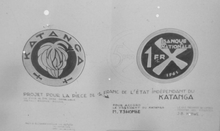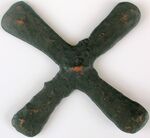- This article is about the coin made in 1961 by the State of Katanga. For the unofficial piece from 2013, see Katangese 1 franc coin (fantasy).
| Franc | |
|---|---|
| File:Katanga franc 1961.jpg | |
| General information | |
| Country | |
| Value |
1.00 franc |
| Years |
1961 |
| Measurements and composition | |
| Mass |
4.8 g |
| Diameter |
22 mm |
| Thickness |
1.5 mm |
| Composition |
bronze |
| Appearance | |
| Shape |
round |
| Alignment |
medallic |
| Edge |
plain |
| Obverse |
Plantains (Musa × paradisiaca), state title |
| Reverse |
Katanga cross, bank title, value, year |
| v · d · e | |
The 1 franc coin is a circulation piece of the former State of Katanga, a short-lived unrecognized republic that proclaimed independence from Congo-Léopoldville and existed from 1960 to 1963. Distributed by the Katangese government in 1961, the piece was produced at the Birmingham Mint of the United Kingdom. During its short period of circulation, the coin carried a face value of 1.00 franc in the areas claimed by Katanga.
Design and production

Charlier's original sketches
On July 11, 1960, under President Moise Tshombe (1919–1969), the State of Katanga declared its independence from the Republic of Congo-Léopoldville. Shortly after seceding, Katanga sought to introduce its own currency: the Katangese franc. Jean-Baptiste Kibwe (1924–2008), Katanga's Minister of Finance, eventually approached Belgian artist Claude Charlier (1930–) and requested he design the breakaway state's 1 and 5 franc coins. Charlier, who first arrived in Belgian Congo in 1952 with the Belgian Armed Forces, settled in Elizabethville (now Lubumbashi) after two years of service. There, in what would eventually become the capital of Katanga, the Belgian established a name for himself as both an artist and a professor at the University of Elizabethville (now the University of Lubumbashi). Charlier accepted Kibwe's request, and produced paper designs for both sides of each coin, and three copper models for the common obverse. These were then submitted to President Tshombe, who approved of the designs. Through a representative of the English company Imperial Chemical Industries (ICI), contacts were eventually made with the Birmingham Mint, which agreed to strike the coins. They entered limited circulation in 1961, but were withdrawn after Katanga's reintegration into Congo-Léopoldville in 1963.
Description

A Katanga cross
The 1 franc piece is composed of a bronze alloy, weighs approximately 4.8 grams, and measures 22 millimeters in diameter and 1.5 millimeters in thickness. It has medallic alignment and a plain edge, and like most coins, is round in shape. Both rims are raised and undecorated, with that on the obverse being significantly larger than that on the reverse.
Displayed in the center of the obverse is a uniquely designed bunch of cooking plantains (Musa × paradisiaca), a hybrid of the banana introduced to parts of Africa. It shows the top of the bunch larger, with a much narrower bottom. This image is enclosed within the circle made by the coin's rim. In an interview with Charlier, Belgian numismatist Leopold Verbist inquired about the design, pointing out that "bananas grow upward and form relatively straight clusters, not toward the bottom and tapering to a point". In response, Charlier explained that he needed to narrow the bottom in order to get the bunch of bananas in the "circle of the coin". Engraved in the rim of the piece, arched in a clockwise direction from the coin's left to right boundaries, is the word "KATANGA", with each "A" stylized without legs. Featured in the bottom left and right rims are two Katanga crosses, a former commodity currency once used in the Congo. Another larger rendition of a Katanga cross appears at the right center of the reverse, superimposed by the French text "BANQUE NATIONALE", which references the National Bank of Katanga. Such an inscription shows displays word on its own line, and as in the "KATANGA" on the obverse, each "A" is engraved without legs. The face value is abbreviated as "1 FR" to the left of the cross, with the numeral shown in a significantly larger font than the word. Written at the bottom of the piece in smaller print, at an angle under the Katanga cross, is the Gregorian date of minting, "1961".
The total mintage of the Katangese 1 franc coin is currently unknown. Only business strikes are known to have been produced. Examples are common in higher grades, particularly Very Fine and Uncirculated.
References
- Numismatic Guaranty Corporation – 1961 Katanga Franc KM# 1
- Numista – 1 Franc (Katanga) (English) (French)
- Claude Charlier, graveur van de munten van Katanga (Dutch)
Katangese franc on the English Wikipedia
Template:Katangese franc
